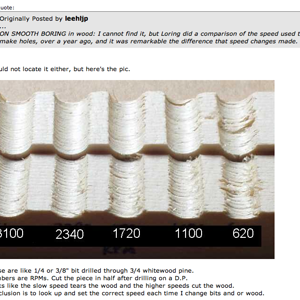Hank has offered some excellent advice.
There are three common problems when drilling wood.
1. Friction causes heat, and the rotation of the bit against the wood causes everything to get warmer. An even greater source of heat is from the friction between the swarf build-up in the flutes of the drill bit at the surrounding wood. The ideal solution is to periodically stop drilling, withdraw the bit from the hole, and clear that swarf. Not only does that totally remove a major source of frictions, it also allows the bit and surrounding wood to cool down a bit. It is also true that using a slower rotational speed may reduce friction, but a slower speed also reduces the efficiency with which the bit cuts into the wood. My view is that a better solution is to use a faster rotational speed to improve cutting efficiency, in combination with periodically stopping to clear the swarf and allow for intermittent cooling.
2. Wood grows seasonally - faster in warm weather, and slower in cold weather. As a result, wood naturally alternates between harder layers (winter growth) and softer layers (summer growth). (this characteristic is more pronounced in woods like ash and oak, and less noticeable but still present in fine-grain woods like maple, walnut and cherry). Its easier to drill if the bit stays within one of the softer layers. What that means is that if you advance the bit too rapidly, there can be a tendency for the bit to 'wander' in order to stay within a softer layer. Solution: slow down the rate at which the bit advances into the wood. Allow the bit to cleanly cut the hole at its leading edge before trying to force the bit to advance into that hole.
3. Drilling a 'blind hole' is easy because the bit never leaves the wood. But when drilling a through-hole, the problem is that when the bit comes close to breaking through the end of the hole, the force of advancing the bit tends to tear the fibers surrounding the exit hole. Forstner bits produce clean holes because the wings cut the surface fibers at the circumference of the hole before the planer portion of the bit removes the interior portion of the hole. And to get a really clean hole with a Forstner bit, you can drill far enough for the center spur to penetrate through, stop, and then reverse drill from the exist side. But that's not practical when drilling axial holes through pen blanks. Instead, you need to do something to support the fibers around the exit hole to prevent tearout. There are two ways to do that - either start with a blank that is longer than required, and then trim away the excess length along with any torn fibers around the exit hole, or else clamp a sacrificial bit of wood at the end of the blank to support the fibers at the exit hole. Slowing down the rate at which the bit advances into the wood also helps; allow the bit to actually cut the hole rather than forcing the bit through that last thin layer of wood at the bottom of the hole resulting in tearout.
Finally, all three problems can be minimized significantly by having a sharp bit. Dull bits don't cut well which leads to additional friction and heating, and requires additional force to advance the bit which can result in the bit wandering off axis and also increases the risk of the bit busting through the bottom of the hole leaving ugly tearout.

